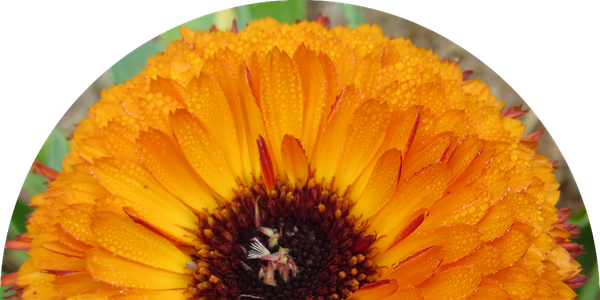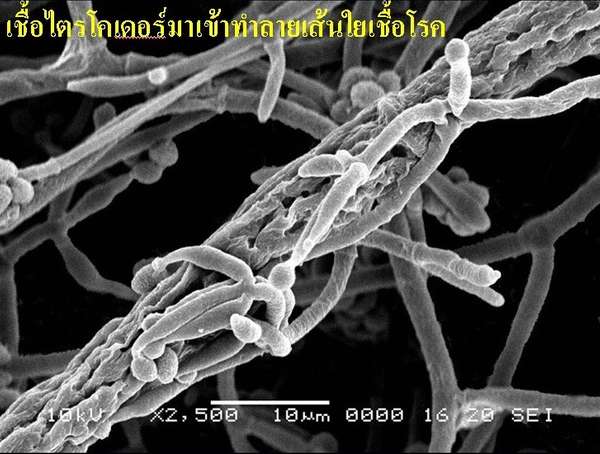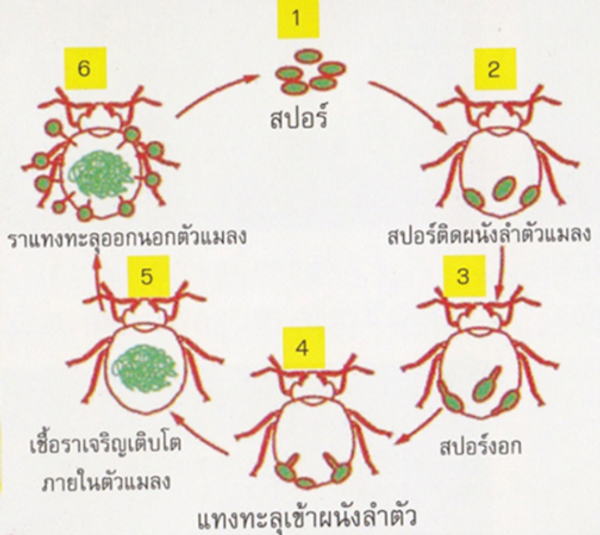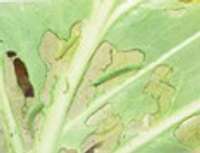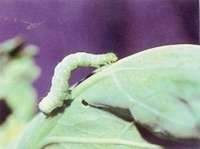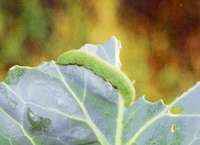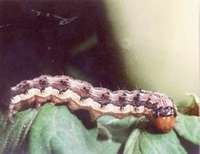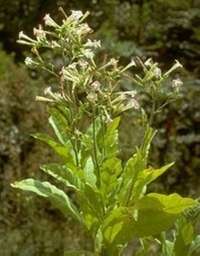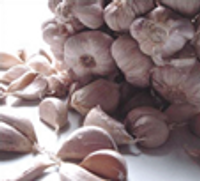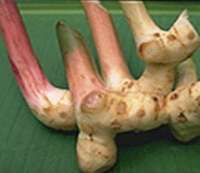Substances Used for Biopest Management
Trichoderma
Trichoderma (Trichoderma harzianum) is a high-grade fungus that grows well in soil, plant matter, animal remains, or other organic material. It consists of white fibres and propagates via spores. When raised in a petri dish the white fibres and green spores are visible; in other varieties the spores may be white or yellow. Trichoderma is known as an “antagonistic” fungicide: it can control many plant diseases that live in soil through exploitation, or parasitic behaviour, competing and consuming the food eaten by pathogens. Aside from this, Trichoderma can help dissolve minerals into forms that are easily consumed by plants, thereby aiding their development, as well as building resistance in plants against all disease-causing fungi and bacteria.
These are ways in which Trichoderma combats diseases:
- Highly Competitive: Trichoderma’s ability to quickly develop its white fibres and spores enable it to succeed in competition against other pathogens or microorganisms in a particular area. Trichoderma is also capable of upsetting other activities of disease pathogens, and lowering their intensity.
- Parasite of Disease Pathogens: Trichoderm’s white fibres are able to bind and pierce other organisms, including those fungi that cause disease. Trichoderma will also eliminate those structures harmful fungi build to facilitate propagation, or to last until the growing season.
- Inhibits or Harms Disease Pathogens: Trichoderma can produce bio-antibiotics, toxins, and enzymes to combat pathogens that cause disease.
- Stimulates Disease Resistance: Trichoderma will help protect plant roots, making the root system healthy, strong, and more resistant to pathogens that cause disease. It will promote seed gemination and seedling growth, while also inducing plants to produce enzymes and proteins such as pentyl pyrone and arsenic acid to stimulate disease resistance.
The Benefits of Trichoderma
Trichoderma can exterminate:
- Pythium spp., which causes rot in seedlings, root and stem rot, and leaf rot in tomato and other vegetables.
- Phytopthora spp., which causes fruit and flower drop in longan, lychee, and durian, and root and stem rot in chili, durian, tangerine, lime, pepper, watermelon, cucumber, tomato, and banana.
- Sclerotium spp., which causes root and stem rot, seedling burn, sclerotium stem rot, and wilt diseases in various crops, including tomato, strawberry, and potato.
- Rhizoctonia spp., which causes root and stem rot, seedling rot, and, in durian, leaf blight.
- Colletotrichum spp., which causes anthracnose in mango, grape, guava, jujube, rose apple, papaya, chili, onion, multiplier onion, shallot, garlic, and potato.
- Alternaria spp., which causes leaf spot in cabbage, kale, chinese cabbage, cauliflower, broccoli, strawberry, and chilli.
- Fusarium spp., which causes leaf burn in orchard trees and various vegetable crops.
******************************************************
Beuvaria
The principles of sustainable agriculture encourage a reduction in the use of chemicals to control pests, something which will also lower capital inputs on farms. It’s therefore necessary, however, to find other means of pest control. In nature there are many natural means of maintaining ecological equilibrium. For example, the spread of disease is one way life on this planet is controlled. Diseases spread by fungi, bacteria, and viruses are often efficient ways of reducing or eliminating certain insect populations. Bacteria and viruses both have limitations, however: insects must consume them for them to work. In agriculture there are many kinds of pests to contend with, at all stages of a plant’s development. Fungi have some advantages over other pathogens: they can enter the body of the plant, and therefore kill many more kinds of insects—all those that suck the juice of the plant: aphids, rice thrips, white mites, mealybugs; all those that eat plants: beetles and caterpillars; and even many insects that live in the soil.
The role of Beuveria in controlling pests
Beuveria (scientific name: Beauveria bassiana). is made of white fibres, which can be observed clearly when grown on a fungus-raising material, or other suitable food, like agar-agar. Beuveria’s insect-attacking ability is realized when its spores make contact with an insect. Within 12 hours of contact, if there is moisture and appropriate food on the body of the insect, the spore will sprout white fibres, pierce the insect’s torso, enter it’s body, and develop inside. At this time the insect will weaken, like a person that has become sick. It will lose its appetite, and, finally, die. When it dies the spores will pierce the torso again and reemerge. Whether it works fast or slow, the success of Beuveria lies in its ability to pierce the body of the insect.
Within 3-7 days of entering an insect Beuveria can produce obvious signs of success. Spraying the fungus over an entire pest-filled area, therefore, enables the spores to make contact with many insects and is an efficient way to lower overall population numbers. It will also not hurt insects that are beneficial predators or parasites, for example Encarsia spp., a parasitic wasp of the family Aphelinidae, or the predatory group of insects known as lacewings, or Chrysopa, which eat pests of the very small variety, such as aphids, mealybugs, butterfly eggs. Note how useful Beuveria can be to businesses and other agricultural producers, considering how easily it can be produced via a process of fermentation, or propagated on a fungus-raising food, to develop spores that can tolerate ultraviolent light, temperature, and high humidity.
Important
Bacillus thunringiensis (Bt) is a microorganism that can effectively control many kinds of caterpillars. It consists of living particles (spores) and the poisonous crystals of bacteria. When a caterpillar eats Bt, the poison created by Bt will slow down the caterpillar’s digestive system, causing convulsions, paralysis, and ultimately death within 1-2 days. For humans, animals, and the environment, however, Bt is non-toxic.
Examples of caterpillars Bt is effective against
1. Diamondback moth 2. Green longan looper 3. Common brimstone butterfly 4. Cotton Bollworm 5. Cluster Caterpillar / Cutworm
How does Bt work?
Bt doesn’t work in the same way as general chemical insecticides. It doesn’t kill insects with the same severity; insects won’t die immediately after spraying. Bt poisons the alimentary canal, the parts of an insect’s body that processes food. Once consumed, Bt will enter the system.
Techniques for the use of Bt
1. Bt should be used on caterpillars that are still small.
2. Bt should be sprayed in the evening when there is less sunshine and more moisture.
3. Bt should always be mixed with a sticking agent. This will help Bt stick to surfaces of plants longer.
4. Adjust the nozzle of your spraying device to allow the maximum output possible, so that as great an area is sprayed as possible.
5. During times when caterpillars are hatching and spreading, Bt should be sprayed once every 3-5 days, and 2-3 rounds, continuously, each time.
6. Bt shouldn’t be mixed with chemicals used to protect plants from disease, especially those which will actively harm bacteria, for example antibiotics, copper oxide, etc. Bt also shouldn’t be mixed with alkaline water.
*The container used to mix the Bt should be stored away from sunlight and heat.
The Merits of Using Bt
1. Bt will target the insects you don’t want, without affecting other kinds that you don’t need to control, for example beneficial predators and parasites.
2. Bt is safe for plants, animals, and humans, both users and consumers.
3. Bt leaves no harmful residue. After spraying your plants with Bt, you can consume them. You don’t have to waste time waiting before you harvest.
4. Bt is highly efficient compared to other microorganisms.
Points to Remember
Bt shouldn’t be used on mulberry plots used as feed for silkworms, and shouldn’t be sprayed anywhere near places silkworms are raised, as its harmful to them.
****************************************************
About Bs
The bacteria Bacillis Subtilis (Bs) is another useful microorganism capable of protecting plants from diseases that arise from many kinds of fungus and bacteria. Bs also doesn’t harm humans, animals, or the environment, and doesn’t leave a harmful residue. It’s a bacteria that naturally lives within plants, so it will not produce harmful effects when it comes into contact with them. It’s a highly beneficial microorganism for its potential to lower the rate of disease. Bs can:
1. directly fight bacteria that cause disease.
2. produce many kinds of antibiotics.
A prominent characteristic of Bs is its superior ability (compared to other microorganisms) to compete for nutrients in nutrient-deficient environments.
Pathogenic fungi and bacteria, and their disease symptoms, that can be controlled by Bacillis Subtilis
|
Disease Symptoms |
Pathogenic Fungi and Bacteria |
|
Root rot |
Fusarium spp. Sclerotium sp. Phytophthora spp. Rhizoctonia sp. Pythium sp. |
|
Soft rot |
Erwinia spp. |
|
Wilt |
Pseudomonas solanacearum |
|
Bacterial blight |
Xanthomonas spp. |
|
Canker |
Xanthomonas spp. |
|
Leaf spot |
Cercospora spp. Septoria sp. |
|
Anthracnose |
Colletotrichum sp. |
Using Bacillis Subtilis
|
Plants |
Targeted Disease |
Rate of Use |
|
Plants of the Brassicaceae family, including kale, cabbage, cauliflower, Chinese cabbage, mustard greens, etc. |
Blight, which is caused by the fungi Fusarium; Gold Leaf Desease, caused by the bacteria Xanthomonas; and Leaf spot, caused by the fungi Alternaria. |
Use 50 grams of Bs for every 20 liters of water. Water holes before planting and apply again every 7-10 days. |
|
Root vegetables, including onion, garlic, ginger, galangal, potato, taro, etc. |
Root rot, which is caused by bacteria such as Erwinia; purple blotch, caused by the fungi Alternaria. |
Use 50 grams of Bs for every 20 liters of water. Water holes before planting and apply again every 7-10 days. |
|
Plants of the Cucurbitaceae family, including watermelon, cucumber, luffa, bitter melon, etc. |
Broken vine disease (Steam Rot), which is caused by many kinds of fungi, including Phythophthora, Pythium, Fusarium, etc. |
Use 50 grams of Bs for every 20 liters of water. Water holes before planting and apply again every 7-10 days. |
|
Other plants, such as tobacco, tomato, chili, asparagus, etc. |
Wilt, which is caused by the bacteria Rhizoctonia; Anthracnose; and leaf spot. |
Use 50 grams of Bs for every 20 liters of water. Water holes before planting and apply again every 7-10 days. |
|
Fruit, including durian, citrus, longan, guava, etc. |
Blossom drop, which is caused by the fungus Botryodiplodia. |
Use 50 grams of Bs for every 20 liters of water. Spray every 7-10 days. |
Natural Methods of Insect Control
Neem Azadirachta indica Juss. Var. Sinensis Valeton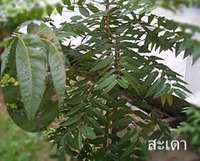
Family Meliaceae
General characteristics: Neem is a perennial that will grow 5-10 metres tall. The trunk has grey or light-brown bark. Every part of the tree has a bitter flavor because of the presence of the chemical Nimbidin, which isn’t poisonous. Flowers grow in bunches at the end of branches,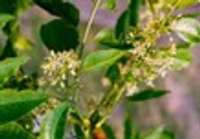 and will appear once old leaves have fallen from the tree. The petals of the flowers are white and perfumed. The tree will flower from December to March.
and will appear once old leaves have fallen from the tree. The petals of the flowers are white and perfumed. The tree will flower from December to March.
Means of Propagation: Seed or cutting.
Parts used: Leaves, fruit, bark, and seeds can all be used in pest control.
Important substances: - Neem bark has the chemical compounds nimbin and desacetylnimbin.
- Neem leaves contain the flavonol quercetin.
- Neem fruit contains the most bitter of substances, bakayanin.
- Neem flowers contain the glycoside nimbosterin (0.005%), very spicy essential oils (0.5%), as well as the chemicals nimbecetin and nimbosterol, fatty acids, and other bitter-tasting elements.
- Neem seeds consist of 45% margosic acid, or “nim oil,” as well as nimbin, numbidin, and the chemical compound azadirachtin, which can kill insects. The seeds contains about 0.4-1% azadirachtin: Indian Neem contains 7.6 mg/gram on average; Thai Neem contains 6.7 mg/g on average; and Philippine Neem (Azadirachta excelsa) contains 4.0 mg/g on average.
Beneficial uses: Neem’s effectiveness against insects can take many forms. It can be used as an insecticide, a repellant, make insects lose their appetite, and stunt their development. For example, neem can make caterpillars to lose their ability to shed their skin (unable to escape or develop into their next phase, the caterpillars die trapped inside), due to an active compound of neem which creates new hormones. These hormones can also affect the egg production and lower the amount of eggs produced. The chemical compound azadirachtin will work well against caterpillars, such as the diamondback moth, cabbage webworm, leaf miner, cutworm, spiny cotton bollworm, bulb worm, stem borer, and glass worm. However it is not effective against the red cotton stainer bug, flea, various beetles, green stink bug, pea-pod borer, mealybugs, and scale insects. It can be used for protection against fungus and bacteria.
Family Solanaceae
Means of propagation: Seed
Parts used: Leaves.
Important substances: Tobacco leaves contain organic acids (malic acid, citric acid, and oxalic acid), the polyphenols rutin acid, chlorogenic acid, and quercitrin, and the essential oils alcohol and nicotine.
Beneficial uses: Increase protection from and control stem borers, cabbageworms, leaf miner, cotton bollworms, butterfly caterpillars, aphids, rice thrips, various mites, and flea beetles. Tobacco can also control and protect plants from diseases.
Method of use: Mix 1 kg of tobacco with 2 liters of water and soak for one night. Strain and remove tobacco leaves, add 54 litres of water (3 buckets), and spray, not letting it touch your body. 3-4 days after spraying your plants can be consumed as normal.
Citronella Cymbopogon nardus Rendle.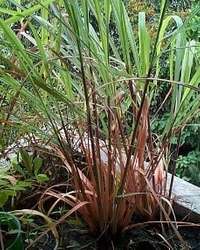
Family Gramnineae
Means of Propagation: Root
Parts used: Leaves and stems
Important substances: Citronella contains methyl eugenol, verbena oil, lemon oil, and indian molissa oil.
Beneficial uses: Citronella can be used to control cutworms, diamond back moths, mosquitoes, and cockroaches, lure male fruit flies, and repel lesser grain borers.
Method of use: 1. The oil of citronella can be mixed with other oils and sprayed to drive away pests.
2. Pound 4kgs of fresh, full-flavoured citronella leaves, 4kg of galangal, and 4kg of neem leaves into a paste, then soak together in 36 liters of water (2 buckets) and leave overnight. Strain free of solids and use this liquid as a concentrate. Mix 10 soup spoons with 20 liters of water to create a good spray for vegetable plots, rice fields, and fruit orchards.
3. Take the root and leaves of citronella and chop into the small pieces, then pound until you have about 500 grams of fine paste. Mix this with 10 liters of water and leave for 1 day. Strain free of solids, mix with a leaf-sticking agent, like dishwashing liquid or shampoo, and spray.
Goat weed Ageratum conyzoides L.
Family Compositae
Means of Propagation: Seed
Parts used: Leaves and stems
Important substances: -
Beneficial uses: Goat weed can be used to control pests.
Method of use: Pound about 1 kg of leaves and stems, then soak overnight in 18 liters of water (1 bucket). This water can be used as a spray.
Non Taai Yaak Stemona collinsae Craib.
Family Stemonaceae
Means of Propagation Root, seed
Parts used: Root
Important substances: Stemonine
Beneficial uses: Non Taai Yaak can be used control and give protection from harmful fungi and bacteria, as well as repelling various kinds of pests.
Method of use: Pound about 1 kg of Non Taai Yaak root and soak overnight in 18 liters of water (1 bucket), or coconut oil. Spray this liquid to kill various kinds of insects and caterpillars.
Family Liliaceae (Alliaceae)
Means of Propagation: Bulb
Parts used: Bulb
Important substances: When garlic has been crushed, or in garlic oil, there is about 0.6-1% allicin, or diallyl sulfide, a strong-smelling compound that is also present in sulphur.
Beneficial uses: Increase protection from and control cutworms, aphids, thrips, various beetles, as well as downy mildew and soybean rust.
Method of use: 1. Soak 1 kg of finely-chopped garlic in kerosene or benzene for 24 hours. Then add a small amount of liquid soap and mix thoroughly. Strain this mixture until only a clear liquid remains. Before using dilute this mixture 20 times, or add about 100 liters.
2. Finely crush three large bulbs of garlic and soak in kerosene for two days. Strain and mix the solution with 1 tablespoon of liquid soap. Mix thoroughly. Before using dilute with 10 liters of water.
3. Pound 1 handful of garlic until fine and soak in half a liter of hot water for 24 hours. Strain free of solids and mix with 4 litres of water and ½ a tablespoon of liquid soap. Spray twice a day, every other day, in the morning.
4. Crush 2 large bulbs of garlic and 2 teaspoons of dried chilli until fine. Add to 4 litres of hot water, adding a little liquid soap. Stir and then strain before using. This formula works well against caterpillars that attack fruit.
5. Dry one handful of peeled garlic cloves in the sun and then pound into a powder. Sprinkle on affected plants when they are not moist.
Turmeric Curcuma domestica (Curcuma longa)
Family Zingerberaceae
Means of Propagation: Root or rhizome.
Parts used: Root or rhizome.
Important substances: Cucurmin, and some essential oils.
Beneficial uses: To control and drive away various insects, including beet armyworms, cutworms, diamondback moth caterpillars, cabbage webworms, and various other caterpillars, bean fly larvae, cowpea weevils, rice weevils, darkling beetles, lesser grain borers, common fruit flies, and water fleas.
Methods of use: 1. Mix 500 grams of crushed fresh turmeric root with 20 liters of water and soak overnight. Strain free of solids and spray your vegetable beds.
2. Mix 1 part finely-pounded turmeric root with 2 parts cow urine. Strain free of solids and spray as a natural insecticide. If you’re using on caterpillars, dilute the solution six times.
3. Mix 500 grams of finely-pounded turmeric root with 2 liters of water and soak overnight. Strain free of solids for a powerful concentrate. Mix this concentrate with 8 liters of water and spray your beds. This solution will effectively repel diamondback moth caterpillars and beet armyworms.
Marigolds Tagetes erecta Linn.
Family Compositae
Means of propagation: Seed and cutting.
Parts used: Flowers.
Important substances: Marigold flowers contain flavonoid glycosides, tagetiin (0.1%), and some fluorescent compounds. The leaves contain the chemical compound kaempferitrin, and the seeds contain oil.
Beneficial uses: Increase protection from and control diamondback moth caterpillars, cabbage worms, brown planthoppers, leafhoppers, scale insects, mealy bugs, aphids, beetles, white flies, flies, grasshoppers, and nematodes.
Method of use: Marigold flowers can be mashed and pressed to produce a concentrated liquid. After straining, mix 10 liters of this liquid with 10 liters of clean water. Before using, add 1 tablespoon of liquid soap to help the solution stick to your plants.
Indian Long Pepper Piper longum Linn.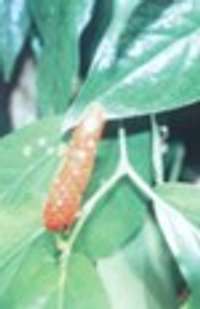
Family Piperaceae
Means of propagation: Cuttings
Parts used: Peppers
Important substances: Old peppers contain the alkaloids piperine (6%) and chavicine, and essential oils (1%).
Beneficial uses: Oil extracted from old peppers will efficiently protect plants from and control pests, including diamondback moth caterpillars, cutworms, pest insects that affect rice storage, beetles, and weevils.
Method of use: Bake 0.5 kg of dried Indian long peppers at a temperature of 50°C and then soak them in 1.5 liters of alcohol. Next, blend the solution until fine and leave overnight before straining out the unwanted solids. Use the remaining liquid to spray.
Lemongrass Cymbopogon Citratus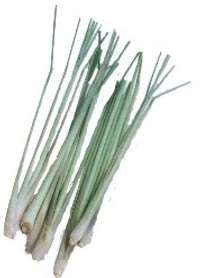
Family Gramineae
Means of propagation: Root
Parts used: Leaves and stems
Important substances: Lemongrass contains the essential oil called lemon grass oil, also known as verbena oil, or Indian molissa oil.
Beneficial uses: This oil contains elements that are poisonous to mosquitoes, flies, and other insects, and acts as an effective repellent. It can also be effective against various fungi and bacteria.
Method of use: Pound about 1-2 kg of fresh leaves and stems until fine. Soak overnight in 18 liters of water. Strain free of solids and spray to repel mosquitoes and other insects.
Boraphet Tinospora crispa Miers. Ex Hook. F&Thoms.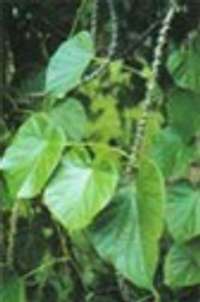
Family Menispermaceae
Means of propagation: Seeds and old vines.
Parts used: Vines.
Important substances: Boraphet contains the bitter principle picroretine. It also contains the diterpenoid Tinosporan, similar to columbin, which can be extracted from the vine and root. Amines are also found in Boraphet: N-trans-feruloyltyramine, N-cis-feruloyltyramine, and the phenolic glucoside tinotuberide.
Beneficial uses: Boraphet can protect plants from stem borers and cutworms. It can also control the following diseases: dead rice disease, wilt, and withered rice disease.
Methods of use: 1. Pound 1 kg of Boraphet vines and soak overnight in about 18 liters (1 bucket) of water. This liquid can be used as an insecticide.
2. For beds to raise seedlings: cut 5 kg of Boraphet vines into small pieces, pound fine, and soak in about 18 litres (1 bucket) of water for two hours. This liquid can then be sprayed on your beds. Alternatively, chop up your Boraphet vines and scatter them directly onto the bed, 1 kg per 4 metres.
3. Cut about 10 kg of Boraphet vines into 5-inch pieces. Scatter these pieces across 1 rai of rice field 7 days after transplanting or sowing your rice. Apply again when your rice is two months old. This is an effective method of controlling stem borers and cutworms.
Bird Chilli Capsicum frutescens Linn.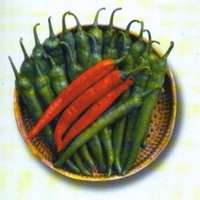
Family Solanaceae
Means of propagation: Seed
Parts used: Chillies, seeds, flowers, leaves.
Important substances: Capsaicin
Beneficial uses: Bird chilli can protect plants from the following pests: cabbage worms, aphids, ladybugs, weevils, insects that live in storage rooms, and ants. Fresh chillies can be used to kill insects, seeds can kill fungus, and leaves and flowers can suppress viruses, including Cucumber Green Mottle Mosaic Virus (CGMMV) and Tobacco Lead Curl Virus (TLCV).
Method of use: Boil 100 grams of dried Bird chillies in 1 liter of water and then pound into a fine paste. Mix the paste with the water and then strain out the solids. Add another 18 liters (1 bucket) of clean water before adding a sticking agent like liquid soap or shampoo. This solution can be sprayed every 7 days. Your solution should be tested a little first, as too concentrated a solution will burn plant leaves. If plants display these symptoms dilute further with water. Care should also be taken to protect the skin of the sprayer from irritation.
Rosebay/Oleander Nerium indicum Mill.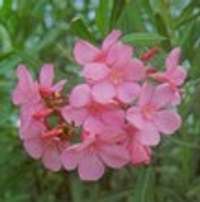
Family Apocynaceae
Means of propagation: Cutting, seed.
Parts used: Flowers, leaves, and stems.
Important substances: The bark and seeds of oleanders contain the glycoside neriodorin, neriin, oleandrin, and folinerin, which have effects similar to digitalis. The bark contains the glycoside cortenerin, which has an effect similar to folinerin.
Beneficial uses: Oleander is effective against many pests that eat the stems and leaves of plants: various beetles, various ants, and leaf-eating insects. The flowers also attract fruit flies.
Method of use: 1. Pound 1 kg of oleander flowers and leaves and soak in 9 liters (½ a bucket) of water for two days. Strain free of solids and spray as an insecticide.
2. Soak oleander leaves and bark for at least 30 minutes and then use this solution to spray ants and insects on the trunks of fruit.
3. Mix 40 grams of finely sliced oleander leaves with 1 kg of soybean seeds. This will allow you to store soybean seeds for six months without attracting pests.
Siam Weed Eupatorium odoratum Linn.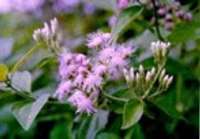
Family: Compositae
Means of propagation: Seed
Parts used: Leaves and stems
Important substances: Stems contain eupatol, coumarin, 1-eupatene, beta-amyrin, flavone, and salvigenin. Leaves contain ceryl alcohol, beta-sitosterol, anisic acid, trihydric alcohol, tannin, isosa kuranetin, and odoratin.
Beneficial uses: Siam weed can be used to exterminate various caterpillars and aphids.
Method of use: Dry the stems and leaves of Siam Weed in the sun and then pound into a powder. Soak 400 grams of this powder in 8 liters of water and leave for 24 hours. This solution can be sprayed every 7 days.
Ginger Zingiber offcinale Vern. Adrak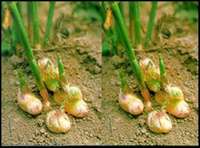
Family Zingiberaceae
Means of propagation: Root
Parts used: Root
Important substances: Ginger contains the important essential oils camphene, cineol, pellandrene, linalool, zingiberene, borneol, and those substances which give ginger its spicy zing, zingerone and shogaol.
Beneficial uses: Ginger can be used to control fruit flies, cowpea weevils, and a wide variety of beetles.
Method of use: Pound fresh ginger root until fine and soak overnight in 1 liter of water. Strain free of solids and add 10 litres of clean water. This can be sprayed on your vegetable beds and fruit trees.
Family Zingiberaceae
Means of propagation: Root
Parts used: Root
Important substances: Galangal contains the essential oils garangol, cineole, pinene, gingerol, shogaol, cineol, camphor, cinnamicaldehyde, 1-acetoxychavicol acetate.
Beneficial uses: Increases protection from and controls rice weevils, red flour beetles, and fruit flies.
Method of use: Pound together 200 grams each of galangal, neem seeds, and lemon grass. Soak overnight in 20 liters of water and then strain free of solids. Dilute this solution with 18 liters of water (1 bucket) for enough insecticide to spray over 1 rai.
Kaffir lime Citrus hystrix DC.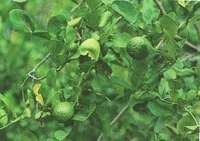
Family Rutaceae
Means of propagation: Seed, cutting.
Parts used: Leaves and fruit.
Important substances: Kaffir lime contains the essential oils pinene, limonene, citronellal, and citronellyl acetate.
Beneficial uses: Kaffir lime leaves contain substances that will repel fruit flies and prevents them from laying eggs. It can also control golden apple snail populations.
Method of use: Kaffir lime leaves contain useful essential oils: chop them up, soak them in water for seven days, and scatter over your rice fields.
Resources:
ECHOcommunity. https://www.echocommunity.org/en/resources/ce2006be-0f4c-4405-8dd9-2fdb6e4ea250. Accessed 26 July 2022
FAO. https://www.fao.org/pest-and-pesticide-management/ipm/integrated-pest-management/en/. Accessed 26 July 2022.
